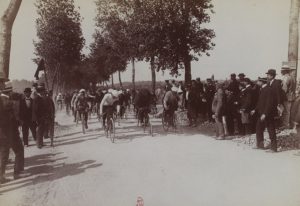
Tour de France is widely regarded as the toughest bicycle race in the world. It is certainly the most popular. The race has 21 stages over 23 days. Tour de France is one of the Grand Tours, which makes it a prestigious event not just any cyclist can enter. But, how did it all begin? Here is the brief history of the race.
Before the Beginning
Much how modern foot races came to be as the result of nobles betting on their servants and messengers, this bicycle race has other events to thank for its beginnings. There were two rival newspapers in France that dealt with sports: Le Vélo and L’Auto. One of the reasons was a complex political scandal, but I won’t get into that now.
In 1902, L’Auto was not too successful, so they came up with an idea: a 6-day bicycle race that would go all over the country. This was not new, but it was also never done at this scale. As races were a popular way to sell more newspapers, organizing such a race would put L’Auto ahead of Le Vélo. If it failed, it would end the paper.
First Race

The first Tour de France was staged in 1903. It was originally a race with 5 stages from Paris to Lyon, then Marseille, Bordeaux, and Nantes, with Toulouse added later. There were only 15 contestants. This made Henri Desgrange, the editor of L’Auto, doubt whether the race would be a success and considered cancelling it.
Instead, he lowered the entry fee and offered daily allowance for the racers that would match what people in factories earned if they achieved a certain speed. He also shortened the race to 19 days.This resulted in a greater turnout. More than 60 people entered the race and Desgrange announced it on 1 July 1903. Maurice Grain was the winner of the race and only 24 cyclists finished the race, as it required great physical exertion.
Later On

The races continued annually, though Desgrange wanted to end the tour in 1904, as it was common for audience members to interfere with the race by beating up contestants and sabotaging their bicycles.
It would be years before the implementation of modern safety standards. Then, the riders were on unpaved roads, with no safety equipment, usually carrying spare tyres wrapped around their bodies so that they could fix their bikes on the road.
In 1926, the route was 5,745 km. A little over ten years later, the bikes became equipped with the latest craze that would let them take on steeper hills and adjust the amount of effort to the power output – derailleurs.
Yellow Jersey
The most coveted achievement that a Tour de France competitor can achieve is the yellow jersey, or maillot jaune. There have been several changes in who gets to wear it, but the gist is that you are allowed to wear the jersey in Tour de France if you have won this Grand Tour the previous year. Eugene Christophe was the first man to wear it in 1919. It was the colour of L’Auto’s paper. Additionally, it is a great way to distinguish the rider from others and see who the leader is.




More Stories
What’s So Special About the Super Bowl?
Top 3 FIFA World Cup Controversies
Short Version of the History of the Olympics